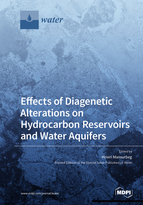Effects of Diagenetic Alterations on Hydrocarbon Reservoirs and Water Aquifers
A special issue of Water (ISSN 2073-4441). This special issue belongs to the section "Hydrology".
Deadline for manuscript submissions: closed (5 March 2022) | Viewed by 14379
Special Issue Editor
Interests: reservoir geology; diagenesis; sequence stratigraphy; petroleum geology; sedimentary petrology
Special Issues, Collections and Topics in MDPI journals
Special Issue Information
Dear Colleagues,
Reservoir quality (porosity and permeability) and heterogeneity in carbonate and siliciclastic hydrocarbon reservoirs and groundwater aquifers are to a large extent constrained by diagenetic processes such as biological, chemical, biochemical, and mechanical changes that occur in sediments subsequent to deposition and prior to low-grade metamorphism. Diagenesis, which has a variable but overall important impact on reservoir-quality evolution, is controlled by several inter-related parameters. These parameters include depositional composition of the sediments, depositional facies, sequence stratigraphy, pore water chemistry, burial history and tectonic setting of the basin, and paleoclimatic conditions.
Carbonate and siliciclastic sediments often undergo multiple stages of diagenesis, which are related to complex patterns of burial-thermal history (subsidence and uplift) that are controlled by the tectonic evolution of the basin. Tectonic evolution of the basin is controlled by the position of the basin with respect to the type and activity along the plate boundaries. Episodes of burial and uplift may result in profound modifications in the pressure–temperature regimes and in the extent of mineral–water interaction, and hence, in various phases of compaction as well as mineral dissolution, recrystallization, transformation and cementation. Diagenesis impacts reservoir quality as follows: (i) destruction by mechanical compaction and extensive cementation, (ii) preservation by prevention of mechanical and chemical compaction, or (iii) generation by dissolution of labile framework grains and intergranular cements.
For this Special Issue, we encourage submissions by geoscientists who are: (i) dealing with hydrocarbon reservoirs and groundwater aquifers and (ii) engaged in deciphering the interplay between mineralogical and chemical changes in carbonates and siliciclastic sediments and diagenetic processes, fluid flow, tectonics, mineral reactions at variable scales, and environments from a variety of sedimentary basins. Numerical modeling of diagenetic reactions using a variety of techniques are essential to understand the pathways of these reactions in different diagenetic environments and, consequently, reservoir quality evolutions.
Prof. Dr. Howri Mansurbeg
Guest Editor
Manuscript Submission Information
Manuscripts should be submitted online at www.mdpi.com by registering and logging in to this website. Once you are registered, click here to go to the submission form. Manuscripts can be submitted until the deadline. All submissions that pass pre-check are peer-reviewed. Accepted papers will be published continuously in the journal (as soon as accepted) and will be listed together on the special issue website. Research articles, review articles as well as short communications are invited. For planned papers, a title and short abstract (about 100 words) can be sent to the Editorial Office for announcement on this website.
Submitted manuscripts should not have been published previously, nor be under consideration for publication elsewhere (except conference proceedings papers). All manuscripts are thoroughly refereed through a single-blind peer-review process. A guide for authors and other relevant information for submission of manuscripts is available on the Instructions for Authors page. Water is an international peer-reviewed open access semimonthly journal published by MDPI.
Please visit the Instructions for Authors page before submitting a manuscript. The Article Processing Charge (APC) for publication in this open access journal is 2600 CHF (Swiss Francs). Submitted papers should be well formatted and use good English. Authors may use MDPI's English editing service prior to publication or during author revisions.
Keywords
- reservoir/aquifer diagenesis
- reservoir/aquifer geology
- petroleum reservoirs
- hydrogeology
- geochemistry of sedimentary rocks
- groundwater flow and mineral diagenesis






